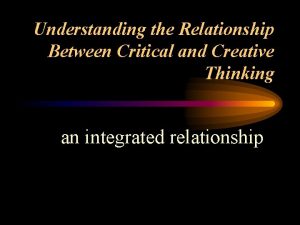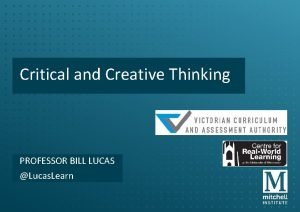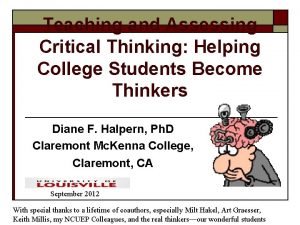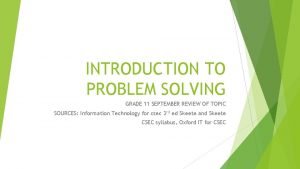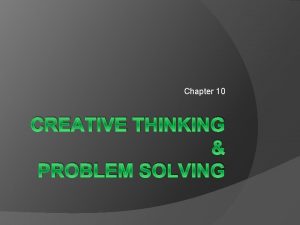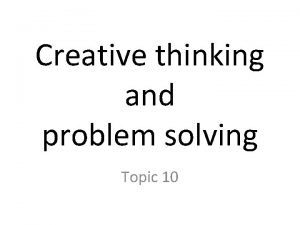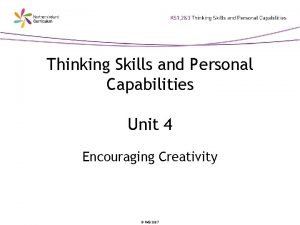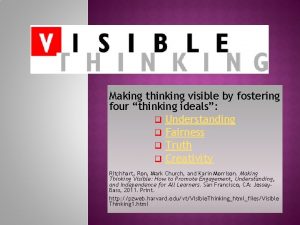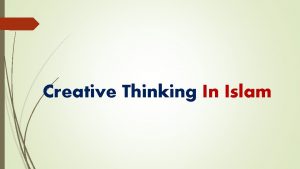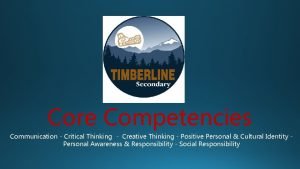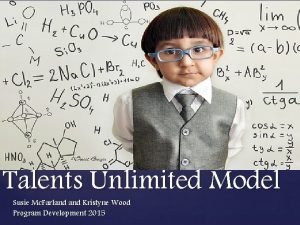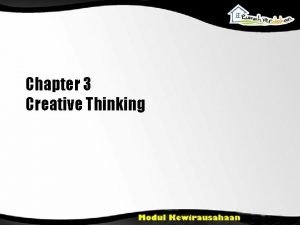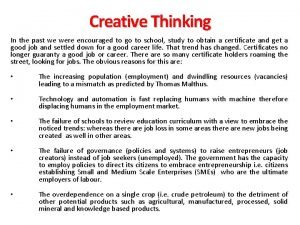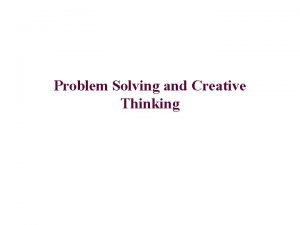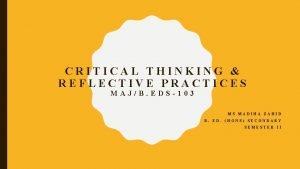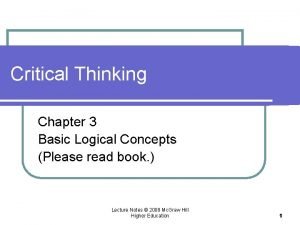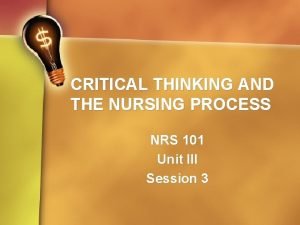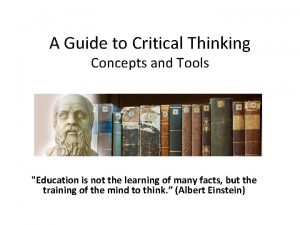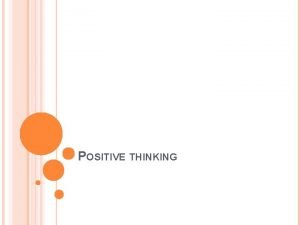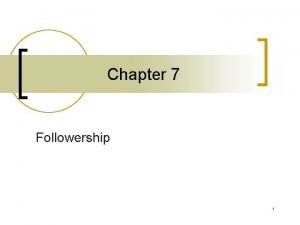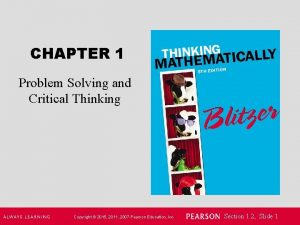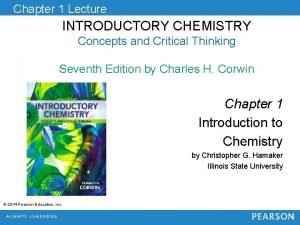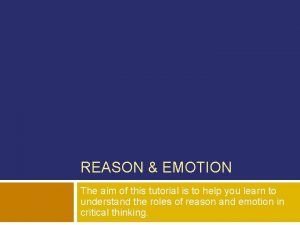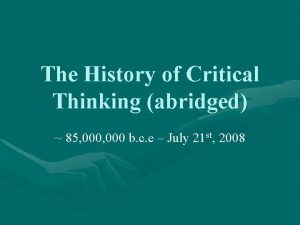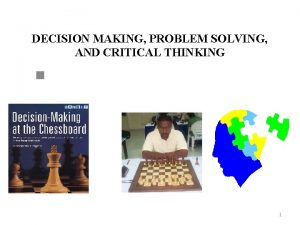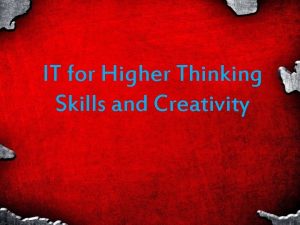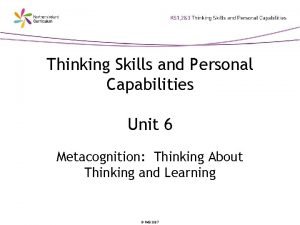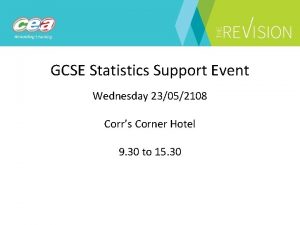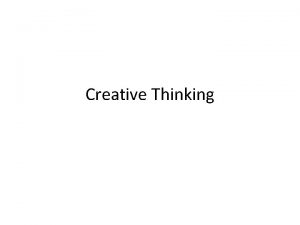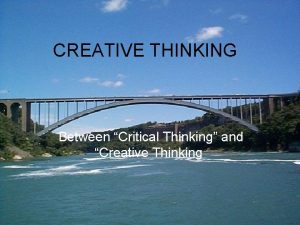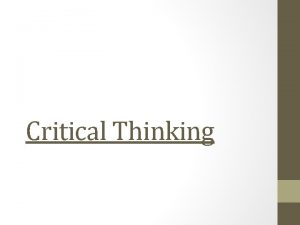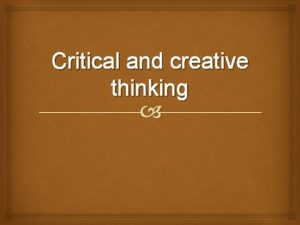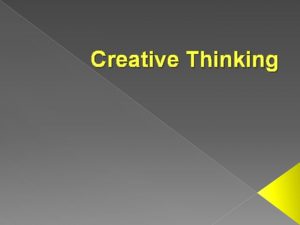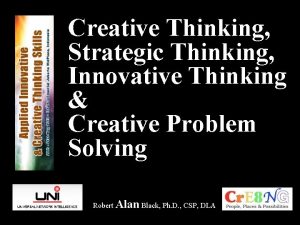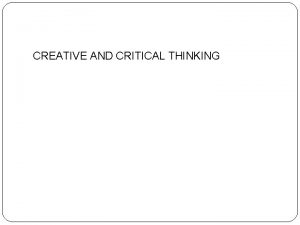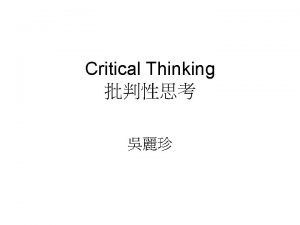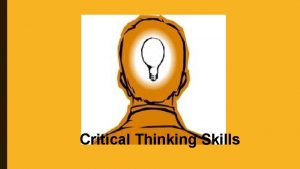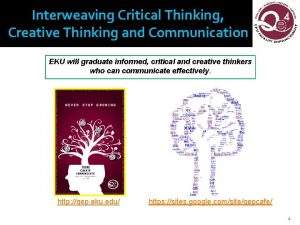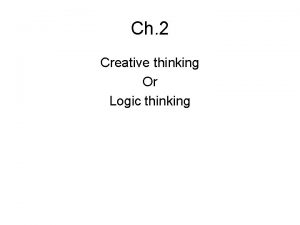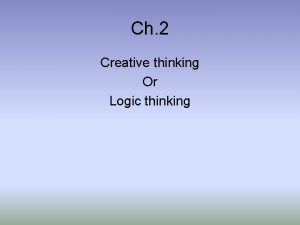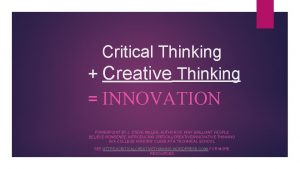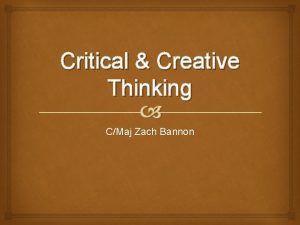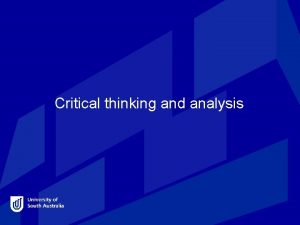Critical and Creative Thinking Skills for Leaders at







































- Slides: 39

Critical and Creative Thinking Skills for Leaders at all Levels Presented by: Bob Schout Power. Skills Training & Development, Inc. On behalf of: Bureau of Land Management

Perception: “F” Cards FEATURE FILMS ARE THE RESULT OF YEARS OF SCIENTIFIC STUDY COMBINED WITH THE EXPERIENCE OF YEARS

Differentiating between critical and creative thinking Section 1

Critical & Creative Thinking

Thinking Styles Abstract Characteristics Indicators in Language You, most often are… Who, on your team, is… Your boss may be… © 2001 -2013 Power. Skills Training & Development, Inc. & Robert J. Schout All rights reserved. Email: bob@yourpowerskills. com Twitter@yourpowerskills Ph. 505 -986 -9208 Linear

Creative Thinking (www. 1000 ventures. com; Vadim Kotelnikov)

Creative Thinking Skills & Abilities 1. 2. 3. 4. 5. 6. 7. 8. Suspend judgment (no right/wrong, good/bad) Subjective (personal viewpoints) Divergence (“another way of looking at it is”) Abstract (flexible, conceptual in nature, based on principles in mind) Generative (“here’s another idea”) Associative (“it’s like this…”) Visual (pictoral, photographic, graphic) Cooperative (“yes, and…”)

Critical Thinking • “Critical thinking is thinking that assesses itself" (Center for Critical Thinking, 1996 b) • Critical thinking is reflective reasoning about beliefs and actions. It is a way of deciding whether a claim is always true, sometimes true, partly true, or false. • Critical thinking asks us to consider whether a piece of knowledge could be rationally justified with clarity and logical consistency. One sense of the term critical means crucial; a second sense derives from Greek meaning discerning judgment

Critical Thinking Skills • Observation • Interpretation (i. e. , a particular version or adaptation of a work, method, or style) • Analysis/Discrimination of Data • Inference (i. e. , a : the act of passing from one proposition, statement, or judgment considered as true to another whose truth is believed to follow from that of the former; b : the act of passing from statistical sample data to generalizations (as of the value of population parameters) usually with calculated degrees of certainty) • Evaluation • Explanation • Meta-cognition/Self-regulation (i. e. , awareness or analysis of one's own learning or thinking processes) (www. rasmussen. edu)

Critical thinking calls for the ability to: 1. Recognize problems or situations and circumstances requiring concentrated thought (e. g. , persistent resistance of people on a team to interact with, relate to, and support one another) 2. Understand the importance of prioritization and order of precedence in problem solving (e. g. , what is the underlying priority/priorities in the situation…. harmony, productivity, avert dissention/conflict, service, etc. ) 3. Gather and marshal pertinent (relevant) information 4. Recognize unstated assumptions and values 5. Comprehend and use language with accuracy, clarity, and discernment; expunging generalist terms (e. g. , do not say: “we want people to get along”) 6. Interpret data, to appraise evidence and evaluate arguments (e. g. , what is the real meaning and impact of words, behaviors, tone, body language, habits, etc. ) 7. Recognize the existence (or nonexistence) of logical relationships between propositions and draw warranted conclusions and generalizations 8. Put to test the conclusions and generalizations at which one arrives 9. Reconstruct one's patterns of beliefs and behaviors based on wider experience 10. Render accurate judgments about specific things and qualities in everyday life

Practices for Practicing Critical Thinking (Karen I. Adsit, Ed: Grayson H. Walker Teaching Resource Center) • Journal or discuss…most important lessons learned or issues at hand; list possible questions or concerns that others may have; etc. • Group learning or conference style learning…assignments – peer group discussion, coaching, cross-training in dialogue format, etc. • Case studies • Reciprocal peer questions • Purposeful ambiguity

Basic application of C&C thinking to work setting Section 2

Systems Thinking • Systems thinking begins with identifying the key stakeholders and processes in the system – those people and processes that can help or hinder the achievement of a particular goal or set of goals. © 2001 -2013 Power. Skills Training & Development, Inc. & Robert J. Schout All rights reserved. Email: bob@yourpowerskills. com Twitter@yourpowerskills Ph. 505 -986 -9208

Strategic Thinking • Strategic thinking begins with starting points, or the levers, for initiating a positive ripple or cascade effect with a group or a system. Strategic thinking focuses on the how, when, why and who. © 2001 -2013 Power. Skills Training & Development, Inc. & Robert J. Schout All rights reserved. Email: bob@yourpowerskills. com Twitter@yourpowerskills Ph. 505 -986 -9208

Opportunity Thinking= Critical & Creative Problem Solving Issue/Topic: Deconstruction Reconstruction Action Plan People 1. 1 a. 1 b. 1 c. What steps are necessary to make each reconstructed answer happen? Which items can be accomplished when… RN: right now…ST: short-term… or LT: long-term… Who should be responsible… Team leader? Team members? Others? 2. 2 a. 2 b. 2 c. 3 a. 3 b. 3 c. 4 a. 4 b. 4 c. 5 a. 5 b. 5 c.

YOU CANNOT SOLVE A PROBLEM FROM THE SAME CONSCIOUSNESS AS IT WAS CREATED.

Opportunity Thinking… • Is optimistic and includes hope and positive thinking • Includes all of the reasons why you think something will work • Is constructive and generative • Looks forward to finding benefits and advantages, and assesses the past in the same way • Looks at possibilities and options • Is speculative and opportunity-seeking, and helps to generate proposals and suggestions • Requires deliberate thought

Observation: Directed Attention Quadrants Room Quadrant 1 Quadrant 2 Quadrant 3 Quadrant 4 Interpretation © 2001 -2013 Power. Skills Training & Development, Inc. & Robert J. Schout All rights reserved. Email: bob@yourpowerskills. com Twitter@yourpowerskills Ph. 505 -986 -9208

Creative and critical thinking begins with perception: 6 common failures in perception 1. We fail to look for something 2. We see only part of the situation 3. We leave things out 4. We fail to take consequences or other people’s thinking into account 5. We fail to generate alternative 6. We don’t allot enough time to see what can be, and needs to be, seen © 2001 -2013 Power. Skills Training & Development, Inc. & Robert J. Schout All rights reserved. Email: bob@yourpowerskills. com Twitter@yourpowerskills Ph. 505 -986 -9208

Tools for Thinking Section 3

D. A. T. T. (Source: Edward De Bono) Tool 1 -- Consequences and Sequels Look ahead to see the consequences of an action, plan, decision, or rule. Tool 6 -- Alternatives, Possibilities, Choices Deliberately try to find other ways. Tool 2 -- Plus, Minus, Interesting Ensure that all sides of a matter have been considered before a decision or commitment is made. Tool 7 -- Other People's Views Put yourself in others' shoes. Tool 3 -- Recognize, Analyze, Divide Break a larger concept into smaller, more manageable parts. Tool 4 -- Consider All Factors Explore all factors related to an action, decision, plan, judgment, or conclusion. Tool 5 -- Aims, Goals, Objectives Focus directly and deliberately on the intentions behind actions. Tool 8 -- Key Values Involved Ensure that your thinking serves your values. Tool 9 -- First Important Priorities Select the most important ideas, factors, objectives, consequences, etc. Tool 10 -- Design/Decision, Outcome, Channels, Action Direct attention to the outcome of the thinking and action that follows.

Three Keys to Success (DATT) Directed Attention Thinking Tools (DATT) 1. Focus: Know which tool you are using and where you are applying that tool 2. Objectivity: Use the tools objectively, not just to support or defend one viewpoint 3. Comprehensiveness: Make an effort to be comprehensive and to scan as widely as possible

OT Problem Solving Process 1. 2. 3. 4. 5. Define the problem a. Redefine the problem – state it in at least five different ways. Generate data about the problem Generate ideas or alternate courses of action for each problem statement: what are the opportunities/possibilities? Choose among the alternative solutions Create a plan of action for one or several of the alternative solutions, and implement the plan.

OT Alternative Problem Statements Defining a problem in more than one way invites the problem solver to generate multiple problem solutions from a variety of perspectives as directed by the definition of the problem. This process focuses on identifying more than one definition of a problem. Using an alternative definition, of people’s feelings about the Company Parking Lot could be defined in the following ways: The parking lot is too small. Too many people want to drive to work. Too many people want to park in the lot. Too many people complain about the parking lot. Depending on the perspective the definition, and therefore the solutions, will differ. What are some of the differing solutions to the problem statements listed above? Coming up with multiple statements and multiple solutions will provide you with systemic resolutions.

P. M. I. P = PLUS M = MINUS I = INTERESTING “It would be interesting if…” (options) “It would be interesting to see whether…” (testing ideas/theories) “What is interesting about this is…” (observations – obj. and subj. )

P. M. I. There are three situations in which the P. M. I. is very useful. 1. Assessment 2. Choice 3. Design

C & S: Consequence and Sequel When to use C & S • Evaluation • Prediction • Design

CAF: Consider All Factors • • Purpose Factors Feasibility Factors Fit Factors Acceptance Factors Impact Factors Involvement Factors Resource Factors Timeline Factors

A. G. O. : Aims, Goals, Objectives When to use A. G. O. 1. Drift and purpose 2. Assessing and prioritizing multiple objectives 3. Developing alternative definitions A. G. O. allows you to develop right now, short-term, and long-term objectives

O. P. V. : Other People’s Views How to use OPV: 1. List all those who are involved or who can impact or will be impacted by the outcome 2. Solicit and/or describe their points of view and perspectives

F. I. P. : First Important Priorities Use FIP to narrow things down. Remember, not everything is equally important 1. What are things that have to be done first? 2. What are things that are most important?

360° Approach to Change and Management of Chaotic Organizations 32 (Source: Peter Vail) Chaotic Stimuli/Desired Change • Organization • Immediate • Short-term • Long-term Vision Strategy Mission & Values • Culture Organiza • Structure tion, Dept. • Skills & People • Leadership Assess internal/external stakeholder values • Worker • Work Place Administrative Processes • Decision Makin • Communicatio • Participation • Resources

The P Wheel © 2001 -2013 Power. Skills Training & Development, Inc. & Robert J. Schout All rights reserved. Email: bob@yourpowerskills. com Twitter@yourpowerskills Ph. 505 -986 -9208

SWOT Analysis • SWOT analysis is identifying strengths, weaknesses, opportunities, and threats GAP Analysis • A gap is the difference between the current state and the future state. © 2001 -2013 Power. Skills Training & Development, Inc. & Robert J. Schout All rights reserved. Email: bob@yourpowerskills. com Twitter@yourpowerskills Ph. 505 -986 -9208

S. W. O. T. ANALYSIS STRENGTHS WEAKNESSES OPPORTUNITIES THREATS © 2001 -2012 Power. Skills Training & Development, Inc. & Robert J. Schout All rights reserved. Email: bob@yourpowerskills. com Twitter@yourpowerskills Ph. 505 -986 -9208

S. W. O. T. ACTION SHEET © 2001 -2013 Power. Skills Training & Development, Inc. & Robert J. Schout All rights reserved. Email: bob@yourpowerskills. com Twitter@yourpowerskills Ph. 505 -986 -9208

About the speaker… Bob Schout is a dynamic speaker, facilitator, trainer, writer and coach who delivers his powerful message of organizational change and personal growth to audiences around the world. Bob is a forerunner in his field, acting as a catalyst for building skills, spirit and community in the workplace. He provides customized management training programs and riveting keynote presentations to corporations, government agencies and non-profit organizations. Bob draws on the strengths of his background, passion and skills to help individuals and organizations enhance relationships, increase productivity and create a culture and climate for success. His educational foundation in Management & Policy, Social Work and Pastoral Studies give him a truly unique perspective on the issues facing organizations today. Now, more than ever, individuals are striving for an ideal work/life balance. Bob directly addresses the growing need for spirit and community at work through interactive programs and inspires audiences to create solutions at the personal, interpersonal and organizational levels. Audiences rave about his engaging and impactful presentations. Bob Schout is a Chicago native with a BA in Social Work and Psychology from Loyola University of Chicago, a MA degree in Social Work and Organization Management & Policy from the University of Illinois and a certificate in Pastoral Studies from Loyola Institute of Pastoral Studies in Chicago. Bob currently lives in Santa Fe, NM. As an attendee of his workshops, Bob asks the you use this material for internal purposes only, letting Bob know when and for what purpose you’re using it, and giving the appropriate credit where appropriate. For further information, questions, or to schedule another presentation with Bob, please contact: 505 -986 -9208 (office) 619 -517 -6299 (mobile)

Training & Consulting Services offered by Power. Skills Training & Development, Inc. o o o 16 Life Skills for Personal Mgt and Work-Life Balance Accountability Principles and Practices Advocacy and Social Justice Skills Anti-Bullying Campaigns for the Workplace & Schools Anger Management at Work Attitude Adjustments at Work Board Development Change Management Coaching and Counseling Skills for Professionals in the Work Environment Coaching Skills Training Basic Skills for Counseling Assessment which Support Coaching, Mentoring and Supervisory Interactions Communication Skills for Professionals Engaging in Compassionate Communication Skills for De-Escalating Intense Interactions Understanding Communication General Principles, Methods, Tools and Practices; Understand how to Give & Receive Feedback Public Speaking Tips, Tools & Techniques Confidentiality and Interviewing Skills for Helping and Client Service Professionals Conflict Management Skills Training Assessing and Resolving Intra-personal, Inter-personal, Project-Related and Organizationally. Driven Conflicts Diagnosing Workplace Norms that Aggravate Relationships at Work Understanding & Managing Conflict Styles Creative and Critical Thinking Skills Cultural Competencies and Diversity Appreciation Fearlessly and Diplomatically Facing Attitudes about Race, Ethnicity, Age, Orientations, and Faith in the Workplace Addressing Harassment and Discrimination in the Workplace Tapping the Strengths of Four Generations in the Workplace Understanding and Managing Styles at Work (e. g. , work styles, learning styles, listening styles, personality styles, etc. ) Customer Service Excellence Skills for Internal & External Customers Dealing with Addictions: Understanding Addictive-Compulsive Behaviors and Applying 12 Step Models in the Work Environment Decision-Making Skills, Practices and Processes De-escalating Aggression & Workplace Violence Delegation Skills and Techniques Emotional Intelligence Skills Empowerment Strategies for the Workplace Ethics, Values and Virtues at Work Expectations and Standards: Setting them and Making them Stick Forgiveness at Work: Practices that Help Your People Let Go, Own Up and Move On Human Resource On-Boarding Practices o o o o o Leadership Development Inspired Leadership: Becoming a Leadership Star Leading Regardless of Level (a. k. a. Leadership for Non-Supervisors) Moving from Peer-to-Leader at Work Leading in all Situations (Problem-Solving, Empowerment, Performance Adjustment, Praise and Motivation, Recognition & Rewarding People) Servant Leadership: Becoming a Servant Leader and Creating a Culture for Leadership so that all may Step into Leadership Personal Leadership in a Professional Environment: Engaging in Self-Awareness, Self-Assessment, virtue and value-based development, managing thoughts and emotions and more Strategic Leadership Skills for change planning, individual development planning, project and program planning, vision-planning, succession planning Meeting Management Mental Health Issues Dealing with Bigotry & Bias within clients Working with MSM to reduce Stigma Healing Religious Wounds Integrating Spirituality into Treatment Interviewing Techniques Confidentiality & other Ethic Standards Understanding Addictions Becoming an Effective Advocate & Ally Confronting & Counteracting Bullying Working Effectively with GLBTQ Clients Gang Intervention Strategies Mentor Program Development Motivation and Morale Building at Work Navigating Political Landscapes at Work Non-Profit Management 101 Non-Profit Resource Development Organization Development: Culture and Climate Diagnosis and Enhancement Performance Management Skills Personality Profiling Power-Development, Influence and Negotiation Skills for Professionals Problem-Solving Skills Training Project and Program Management Training Recognition and Rewards at Work Relationship Building Skills for Professionals Strategic Thinking and Planning Stress Management and Work/Life Balance Styles at Work Succession Planning Skills and Strategies Supervisory Skills Training Team Building and Group Work Skills Tele-Work Management Skill-Building Time and Task Management Training-the-Trainer and Facilitation Skill-Building Understanding Mental Health Issues at Work Volunteer & Internship Management Skills

For More Information Contact: Bob Schout Power. Skills Training & Development, Inc. Mobile: 619 -517 -6299 Office: 505 -986 -9208 Email: bob@yourpowerskills. com Twitter@yourpowerskills Services offered: E-mail: bob@yourpowerskills. com Web: www. yourpowerskills. com Retreat & Meeting Facilitation Personal & Professional Life Coaching Keynote Presentations Strategic Planning & Support Executive Coaching Employee & Management Training Organizational Development Tele-Class Delivery
 Perbedaan critical thinking dan creative thinking
Perbedaan critical thinking dan creative thinking Relationship between creative and critical thinking
Relationship between creative and critical thinking Critical and creative thinking vic curriculum
Critical and creative thinking vic curriculum Professor bill lucas
Professor bill lucas Critical semi critical and non critical instruments
Critical semi critical and non critical instruments Semi-critical
Semi-critical Critical thinking skills
Critical thinking skills Creative thinking and problem solving grade 11
Creative thinking and problem solving grade 11 Creative thinking to solve business problems
Creative thinking to solve business problems Creative thinking and problem solving grade 10
Creative thinking and problem solving grade 10 Icedip model full form
Icedip model full form Thinking routine step inside
Thinking routine step inside Creative thinking in islam
Creative thinking in islam Creative thinking core competency
Creative thinking core competency Talents unlimited
Talents unlimited Contoh scumps
Contoh scumps Wikipedia critical thinking
Wikipedia critical thinking Creative thinking
Creative thinking Creative thinking
Creative thinking Paul torrance
Paul torrance Nine dot problem solution
Nine dot problem solution Nursing process and critical thinking
Nursing process and critical thinking Critical thinking and reflective practices
Critical thinking and reflective practices Logic and critical thinking chapter 3
Logic and critical thinking chapter 3 Evaluation in nursing process
Evaluation in nursing process Critical thinking concepts
Critical thinking concepts Critical thinking positive and negative
Critical thinking positive and negative Independent critical thinking
Independent critical thinking Chapter 1 problem solving and critical thinking
Chapter 1 problem solving and critical thinking Introductory chemistry concepts and critical thinking
Introductory chemistry concepts and critical thinking Emotions and critical thinking
Emotions and critical thinking An introduction to critical thinking and creativity
An introduction to critical thinking and creativity History of critical thinking
History of critical thinking Critical thinking problem solving and decision making
Critical thinking problem solving and decision making Guided hypermedia projects
Guided hypermedia projects Thinking skills and personal capabilities
Thinking skills and personal capabilities Chain base index numbers gcse statistics
Chain base index numbers gcse statistics Slidetodoc.com
Slidetodoc.com Which is the hardest
Which is the hardest Critical thinking guidelines
Critical thinking guidelines

